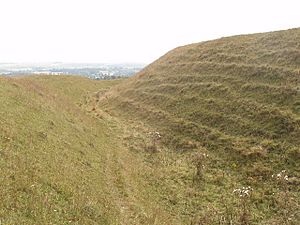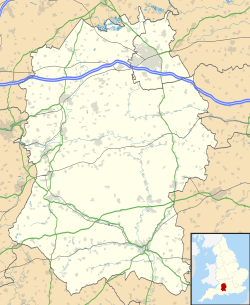Battlesbury Camp facts for kids

Iron age earth walls and ditch, at the eastern edge of Battlesbury Hillfort
|
|
| Location | Wiltshire |
|---|---|
| Coordinates | 51°12′34″N 2°08′51″W / 51.2095°N 2.1474°W |
| Area | 23.5 acres |
| History | |
| Periods | Bronze Age, Iron Age |
| Site notes | |
| Excavation dates | yes |
| Condition | good |
| Public access | yes |
Battlesbury Camp is an ancient hill fort located on Battlesbury Hill. It is near the town of Warminster in Wiltshire, South West England. This site dates back to the Iron Age.
A hill fort is a type of fort built on a hill. Battlesbury Camp is a bivallate hill fort. This means it has two main sets of ditches and banks for protection. Digs and studies at the site have found many interesting items. These finds help us learn about the people who lived there long ago.
Contents
What is a Hill Fort?
Hill forts were built a very long time ago. They appeared in Britain during the Late Bronze Age and Early Iron Age. This was around 3,000 years ago.
People built these forts for different reasons. They might have been used for protection. They could have been safe places during times of trouble. Some experts think they were built because more people were living in the area. This meant there was less land for farming.
These forts also served as important community centers. People would gather there for trade. They might also have held special ceremonies. So, hill forts were not just for fighting. They were also central places for daily life.
Exploring Battlesbury Camp
Battlesbury Camp sits on top of a hill. The fort's defenses follow the natural shape of the hill. This made it very hard to attack from the west and northeast.
The fort has three ditches and earth banks (ramparts) in most places. On the southeast side, it has two ditches and banks. The whole area inside the fort is about 23.5 acres. There are entrances at the northwest and northwest corners.
What Was Found Inside?
Archaeologists found many pits inside the fort. These pits held items from the late Iron Age. They found pieces of pottery. They also found part of a chariot wheel. Tools like an iron carpenter's saw were discovered. A latch-lifter for a hut door was also found.
Other finds included querns (stones for grinding grain) and whetstones (for sharpening tools). They also found sling stones and animal bones. All these items show that people lived there all the time. These finds date back to the 1st century BC.
Sadly, it seems the people living here may have faced a difficult end. Many graves were found outside the northwest entrance. These graves held the bodies of men, women, and children. We don't know for sure what happened. It might have been a battle with Roman soldiers. Or it could have been a fight between different local tribes. This likely happened before the Romans took over Britain.
Ancient Burials
The southwest part of the hill fort was built around older burial mounds. These mounds are called tumuli or barrows. They are from the Bronze Age.
One large circular mound was found inside the fort's ditch. It was dug up, but nothing was found inside. A bit further west, two other mounds were found. The big inner earth bank of the fort goes right over them.
When these two mounds were opened, they contained burials. In the largest mound, burnt human bones were found. In the smaller one, two skeletons were found. One skeleton's head was resting on the other's chest. On the chest of the larger skeleton, a small stone ring or bead was found. This was probably worn as a good luck charm.
Later Discoveries
More digs happened near Battlesbury Camp in 1998. These digs found signs of settlements from the late Bronze Age to the middle Iron Age. They found ditches, roundhouses, and other structures. Many pits were also discovered.
Some of these pits contained human burials. Other pits had special collections of items. These included artifacts and animal bones. They seem to have been placed there on purpose. This gives us clues about their beliefs and customs.
Where is Battlesbury Camp?
The site is located east of the town of Warminster. It is in the county of Wiltshire. The top of the hill is 208 meters (about 682 feet) above sea level. There is a special marker called a triangulation station there.
Another hill fort, Scratchbury Camp, is nearby to the southeast. The area around Battlesbury Camp is open to the public. You can walk on the public footpaths. However, you need to be careful not to go into the military firing ranges. These are part of Salisbury Plain and are just to the northeast.
Images for kids




